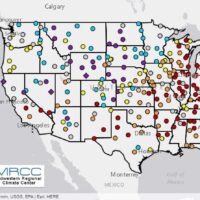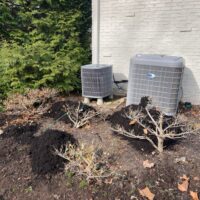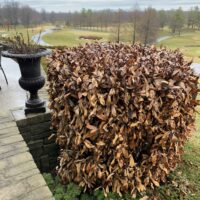 Purdue University - Extension - Forestry and Natural Resources
Purdue University - Extension - Forestry and Natural Resources
Got Nature? Blog

Figure 1. Accumulated Winter Season Severity Index for winter 2022-2023 in the United States from the Midwest Regional Climate Center.
Purdue Landscape Report: Remember the pre-Christmas freeze? What about the extremely long fall? The Midwest experienced above-average temperatures through most of the winter, but those extremely cold temps in late December made for more than a few pipes to freeze in the southern part of the Midwest. The dichotomy in weather patterns over the last several years has been mind-boggling. We’ve gone from flooding to drought in most recent growing seasons, to the extremes in temperatures this winter. Though it’s an inconvenience for us, plants don’t have the option of heated seats or umbrellas, thus stress or death can occur in these extremes.
East of the Mississippi River, the 2022-2023 winter has been significantly milder than average, based on past climate models (Fig. 1). We don’t typically have cold injury in late December, but drastic changes in temperatures can cause pernicious effects on plant health. The entire state of Indiana had the drastic changes in temperature December 22-27, 2022 (Table 1).

Table 1. The high and low temperatures (F) in Evansville, Indianapolis, and Fort Wayne December 22-27, 2022. Data courtesy of the National Weather Service.
There’s on-going evidence of damage across the Midwest from the late/long fall and extreme cold that was experienced in mid-late December. We’ve observed some perennial evergreens, i.e., American holly, Meserve holly (Fig. 2), and skip laurel (Fig. 3), damaged or killed during this winter, especially in the southern parts of the Midwest. In addition, some deciduous trees have significant bark cracking (Fig. 4). Though these plants are hardy well below the temperatures that were experienced, the maximum dormancy wasn’t yet reached by plants due to the warm temperatures so late into the winter season.

Figure 2. A planting of Meserve hollies died during the winter of 2022-2023 due to cold injury. Photo via Gabriel Gluesenkamp.
There’s on-going evidence of damage across the Midwest from the late/long fall and extreme cold that was experienced in mid-late December. We’ve observed some perennial evergreens, i.e., American holly, Meserve holly (Fig. 2), and skip laurel (Fig. 3), damaged or killed during this winter, especially in the southern parts of the Midwest. In addition, some deciduous trees have significant bark cracking (Fig. 4). Though these plants are hardy well below the temperatures that were experienced, the maximum dormancy wasn’t yet reached by plants due to the warm temperatures so late into the winter season.
Plants survive through the winter by entering a phase of dormancy in which the plant is in a state of suspended animation. The dormancy process in plants is a complicated series of internal events caused by external events, that allow perennial plants to protect themselves during environmental changes, such as winter.
For more images and full article view: Cold Injury During a Very Mild Winter?
Resources:
The Purdue Landscape Report
Purdue Landscape Report Facebook Page
Fall webworms: Should you manage them, Got Nature? Blog
Purdue Landscape Report Team Begins New Virtual Series, Got Nature? Blog, Purdue Extension – Forestry and Natural Resources (FNR)
Tree wounds and healing, Got Nature? Blog
Shrubs and Woody Vines of Indiana and the Midwest, The Education Store
Tree Risk Management, The Education Store
Why Is My Tree Dying?, The Education Store
ID That Tree, Purdue Extension-Forestry & Natural Resources (FNR) YouTube playlist
Subscribe to Purdue Extension-Forestry & Natural Resources (FNR) YouTube Channel
Kyle Daniel, Commercial Landscape and Nursery Crops Extension Specialist
Purdue Horticulture & Landscape Architecture

Recent Posts
- Report Spotted Lanternfly – Purdue Landscape Report
Posted: April 10, 2024 in Alert, Forestry, Invasive Insects, Plants, Wildlife, Woodlands - Declining Pines of the White Variety – Purdue Landscape Report
Posted: in Alert, Disease, Forestry, Plants, Wildlife, Woodlands - Are you seeing nests of our state endangered swan? – Wild Bulletin
Posted: April 9, 2024 in Alert, Forestry, How To, Wildlife - Cicadas in Spring! – Purdue Landscape Report
Posted: in Forestry, Plants, Safety, Wildlife - New Deer Impact Toolbox
Posted: April 7, 2024 in Forestry, Land Use, Plants, Publication, Safety, Wildlife, Woodlands - 2024-25 Fishing Guide now available – Wild Bulletin
Posted: April 4, 2024 in Alert, Aquaculture/Fish, Aquatic/Aquaculture Resources, How To, Ponds, Wildlife - Help Research Chronic Wasting Disease – Wild Bulletin
Posted: April 3, 2024 in Disease, Forestry, How To, Safety, Wildlife, Woodlands - Indiana Reptiles and Amphibians – IFWOA Webinar
Posted: April 1, 2024 in Forestry, How To, Webinar, Wildlife, Woodlands - Birding through the Seasons – IFWOA Webinar
Posted: in Forestry, How To, Webinar, Wildlife, Woodlands - Look Out for Invasive Carp in Your Bait Bucket – Wild Bulletin
Posted: March 31, 2024 in Alert, Aquaculture/Fish, Aquatic/Aquaculture Resources, Invasive Animal Species, Wildlife
Archives
Categories
- Alert
- Aquaculture/Fish
- Aquatic/Aquaculture Resources
- Ask the Expert
- Christmas Trees
- Community Development
- Disease
- Drought
- Forestry
- Forests and Street Trees
- Gardening
- Got Nature for Kids
- Great Lakes
- How To
- Invasive Animal Species
- Invasive Insects
- Invasive Plant Species
- Land Use
- Natural Resource Planning
- Nature of Teaching
- Plants
- Podcasts
- Ponds
- Publication
- Safety
- Timber Marketing
- Uncategorized
- Urban Forestry
- Webinar
- Wildlife
- Wood Products/Manufacturing
- Woodland Management Moment
- Woodlands
